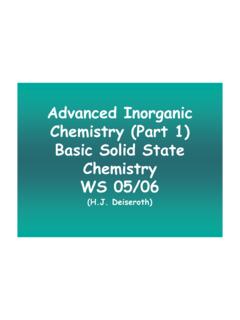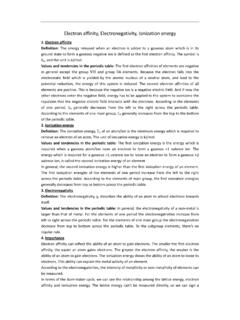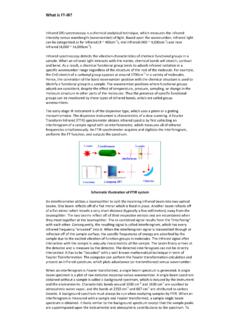Transcription of Vibrational spectroscopy Vibrational Spectroscopy (IR, Raman)
1 11 Vibrational Spectroscopy (IR, Raman) Vibrational spectroscopyVibrational Spectroscopy is an energy sensitive method. It is based on periodic changes of dipolmoments (IR) or polarizabilities (Raman) caused by molecular vibrations of molecules or groups of atoms and the combined discrete energy transitions and changes of frequen- cies during absorption (IR) or scattering (Raman) of electromag- netic radiation of wavelengths from 1 to 300 m (selection rules).One can get/detect: the presence of known compounds (finger print) the components of an unknown compound (functional groups) and thus a likely structure of a compound changes in the concentration of a species during a reaction the properties of bonds (bond strength, force constants) state and order parameters of phase transitions22 Vibrational Spectroscopy (IR, Raman) Vibrational spectroscopyIn order to describe the 3N-6 or 3N-5 different possibilities how non-linear and linear molecules containing N atoms can vibrate, the models of the harmonic and anharmonic oscillators are modes of vibration (normal modes) give rise to absorption bands (IR) if the sample is irradiated with polychromatic light of suitable wavelengths upon changes of the dipole moment = E + E2 +.
2 Scattered light (Raman) if the sample is irradiated with monochromatic light of a suitable wavelength upon changes of the polarizabilities with characteristic energies/frequencies/wavenumbers, intensities and Fwhm s to be determined and frequencies are in the range of 1012 to 3 1014 Hz with Vibrational energies from to 120 kJ/mole (4 10-3 - eV), wavenumbers from 33 to 104 cm-1, and wavelenghts from 300 to 1 intensities are proportional to the square of the changes of the dipole moments and SpectroscopyWavelengths and energies in Vibrational spectroscopyWavenumber reciprocal of : 1/ (cm-1)Wavelength in nmVis, IR, and Raman areas drawnin a scale of linear wavenumbers and some lasers sources44 Vibrational Spectroscopy - the main principleVibrational SpectroscopyHClr0 Center of mass is not allowedoo shift during the vibrationExtension from r0 (equilibrium distance)Absorption of energy ERelaxation to r0 VibrationTogether with molecular vibrations also molecular rotations are excitedas well since rotational energies are much smaller (~ Evib.)
3 !Hooke s lawF = - k xV = -F dx = kxdxV = k x2 Spring with rate/spring constant kk55 Harmonic Vibrational levelsWarning: Molecular vibrations are essentially anharmonic! Vibrational SpectroscopyZero-point vibration Zero-opint energy E0 Potential curveV = /~~k= Wavenumberk = rate/force constant = reduced mass ~2121mmmm+= F = - k xV = -F dx = kxdxV = k x2 Harmonic Oszillator F = -kx = m b = m d2x/dt2 0 = (1/2 ) (k/m)1/266 Vibrational energy levels in harmonic/anharmonic approximationPotential curve of the harmonic oscillator(En : Vibrational levels, E0 : Zero-point energy) n = 1 Vibrational SpectroscopyPotential curve of the anharmonic oscillator(E0 : Zero-point energy, ED : Dissociation energy)EVIB = h osc (n + ) - h2 2/(4ED ) (n + )2 ( n = 1, 2, ..)For anharmonic vibrations the distances of neighboring Vibrational levels decrease with increasing n (the thickness of the arrows stand for the transition probabilities and in- tensities respectively).
4 Condition for IR d 0, condition for Raman: d 0 Selection rules!77 Vibrational states and frequenciesVibrational coupling in zig-zag chains of different lengthsExcitation of a Vibrational state in the electronic ground state S0 by a: infrared absorption, b: Raman scattering, c: inelastic neutron scattering, d: of frequencies in case of a free molecule (a), static (b) and dynamical (c) coupling in a crystal lattice, and dependence on the wave vector k for all unit cellsVibrational Spectroscopy88 Vibrational SpectroscopyNormal modesEach atom of a molecule (structure) has three degrees of freedom (dof) with respect to displacements, resulting in 3N dof for N atoms. Substracting the dof for translations (3) and rotations (3 or 2), 3N-6 and 3N-5 degrees of freedom are expected for non-linear and linear N-atomic molecules, corresponding vibrations are called normal modes.
5 It is valid that:1. All atoms of a molecule move with the same frequency and in phase, and they move simultaneously through the points of maximum elongation and equilib- rium displacement r0 while the mass center remains amplitudes of the different particles can be The normal vibrations (typically) do not interfere with each other (orthogonality principle). number of normal vibrations ( Vibrational degree of freedom) is3N-6 for non-linear molecules3N-5 for linear molecules99 Vibrational SpectroscopyNormal modesEvery Vibrational mode exhibits its own pattern (vector, matrix) for the atomic displacements ( x, y, y), leading to normal coordinates, but the Vibrational modes are usually not known:Assignment of the Vibrational modes via symmetry properties of the molecules (point group, irreducible representation, character, character tables).
6 Symmetry of vibrations (symmetry species = Rassen, types of vibration) Symmetry species (Rassen) of the modes are denoted after Mulliken:A = symmetric, B = antisymmetric with respect to Cn ; E, F, G, H = 2-, 3-, 4-, 5-fold degenerate with respect to Cn ;g = symmetric with respect to i (from German gerade);u = antisymmetric with respect to i (from German ungerade); Index subscripts of A or B: 1 = symmetric, 2 = antisymmetric with respect to Cn or Sn (a mirror plane);Example: A2g is a vibration that is symmetric with respect to Cn and i (character = 1) and antisymmetric with respect to Sn or (character = -1).1010C3vE2C33 vA1111zx2+y2, z2A211-1 RzE2-10(x,y) (Rx ,Ry )(x2-y2, xy) (xz, yz)Point groupSymbolSymmetry operationsActive vibrations inSymmetry species (Rassen)Group charactersCombinations of the symbols x, y, z, Rx, Ry and Rz, the first three of which represent the coordinates x, y and z, and the last three of which stand for rotations about these axes.
7 These are related to transformation properties and basis representations of the table for space group C3vIR RamanNormal modes1111 Normal modes (Examples)Three normal vibrations of H2 O and their wavenumbersVibrational Spectroscopy3N 6 Modes (3N 5, if linear) = Wavenumberk = Force constant = Reduced mass /~~kFour normal vibrations of CO2 (linear) 1 2 3 = 4 4 = 31212 Auswahlregeln Normal modes of vibration (IR-) activityDipole moment changes during the vibration!OCOOCOOCOOCOHOHHOHHOH sym: 1596 cm-1 sym: 3652 cm-1 asym: 3756 cm-1 666 cm-1 entartet asym: 2350 cm-1 asym: 1340 cm-1+-+666 cm-1entartetIR-aktivIR-aktivIR-aktiv IR-inaktiv(Raman-aktiv)IR-aktivStretchin g vibrationChanges of bond lengthsBending vibration Changes of bond anglesIR-aktivVibrational Spectroscopy1313S14 Normal modes (Examples)1414 Normal modes (Examples)1515 Normal modes (Examples)1616 Typical values for stretching and bending vibrations Molecule stretchingbendingC - H2800 - 3000N - N3300 - 3500H2 O3600 - 30001600C = O1700C = C1600SO32-970 ( s )930 ( as )620 ( )470 ( )Schwingungsspektroskopie1717 Sources for IR- (and Raman-) radiationConventional lamps are not adequate, because near IR: ~ 700 to 1400 nm.
8 Mid-wavelength/far IR: > 1400 nm IR-Spectroscopy1818 lamp with Nernst rod ZrO2 /Y2 O3 ionic conductor, KAll heated materials emit infrared radiationIR-Source (Globar, Nernst-Lamp)new schematic usedGlobar (SiC, ~ K)IR-Spektroskopie1919 Range Source Monochromator DetectorFar IR Nernst rod CsI-prism; grating Bolometer (ceramic rodMid IR with heating coil) LiF-prism; grating Bolometer Near IR Light-bulb quartz-prism PbS-Cell; Se-CellNernst rod: cub. ZrO2 stabilized by rare earth elements ( Y3+)Near IR: ~ 700 bis 1400 nm; Mid-wavelenght/Far IR: > 1400 nm IR-sources, monochromators and detectorsIR-Spektroskopie2020IR-Detector sMain principle and a picture of a bolometer: A cooled metal foil (Pt, Au) absorbs IR radiation. The resulting rise of the temperature is detected by a resistor-type - SpectrometerDouble beam, optical gratingIR-SpectroscopyFourier-Transform (FT)2222 fourier -transform spectroscopyIR- Spectroscopy Classical (grating, prism) IR Spectroscopy has been replaced by the much faster ftir Spectroscopy .
9 In the case of the classical ( non FT) infrared Spectroscopy the different wavelengths had to be measured successively. In the case of the ftir technique the complete range of interest is measured at fundamental instrument for ftir is the Michelson interferometer that replaces the monochromator. The sample is irradiated by polychromatic light and a movable mirror produces a time dependent signal that is transformed by fourier transformation into a frequency (FT) spectrometrySchematic representation of a Michelson interferometer (a) with interferogram (b) and spectrum (c) obtained by fourier transform. a) Michelson InterferometerS radiation source, Sa sample chamber, D detector,A amplifier, M1 fixed, M2 movable mirror,BS beam splitter, x mirror deflection, L distanceb) InterferogramSignal recorded by the detectorc) SpectrumObtained by fourier transform (FT)From the interferogramIR-Spectroscopy242435003000 2500130011501000850700400 /cm-1Sr(HPO OH)22RT122612351225124111641155117011687 5877969468568628812439 2433243424402899303230192400243223002303 3176317529632783319132143080 RTTTTTSr(SeO OH)22 Transm ission B(OH) (PH) (OH) (OH)Cs2 CrCl5 4H2 OBaSO3 KMn(SeO2 OH)3 Examples from current research activitiesIR-Spectroscopy2525 Raman spectroscopyRaman spectroscopyIrradiation of a sample with monochromatic light of a suitable wave length may force oscillations of the small portion (IRayleigh /I0 ~ 10-5)
10 Of the absorbed radiation energy is scattered with the same frequency as the incident light into all directions of space (elastic, Rayleigh scattering).An even smaller portion (IRaman(Stokes) /I0 ~ 10-8) of the irradiated energy will be transformed into molecular vibrations (with a corresponding change of the polarizability tensor ) and thus leads to an absorption of Vibrational energy from the scattered light. The scattered light therefore has a lower frequency than the irradiated light (inelastic, Raman scattering, Stokes).If the radiation interacts with a Vibrational excited molecule then the scattering process may result in an emission of energy to the scattered light. Thus the scattered light has a larger frequency compared to the irradiated light (inelastic, Raman scattering, anti-Stokes, IRaman(anti-Stokes) /I0 ~ 10-11).






